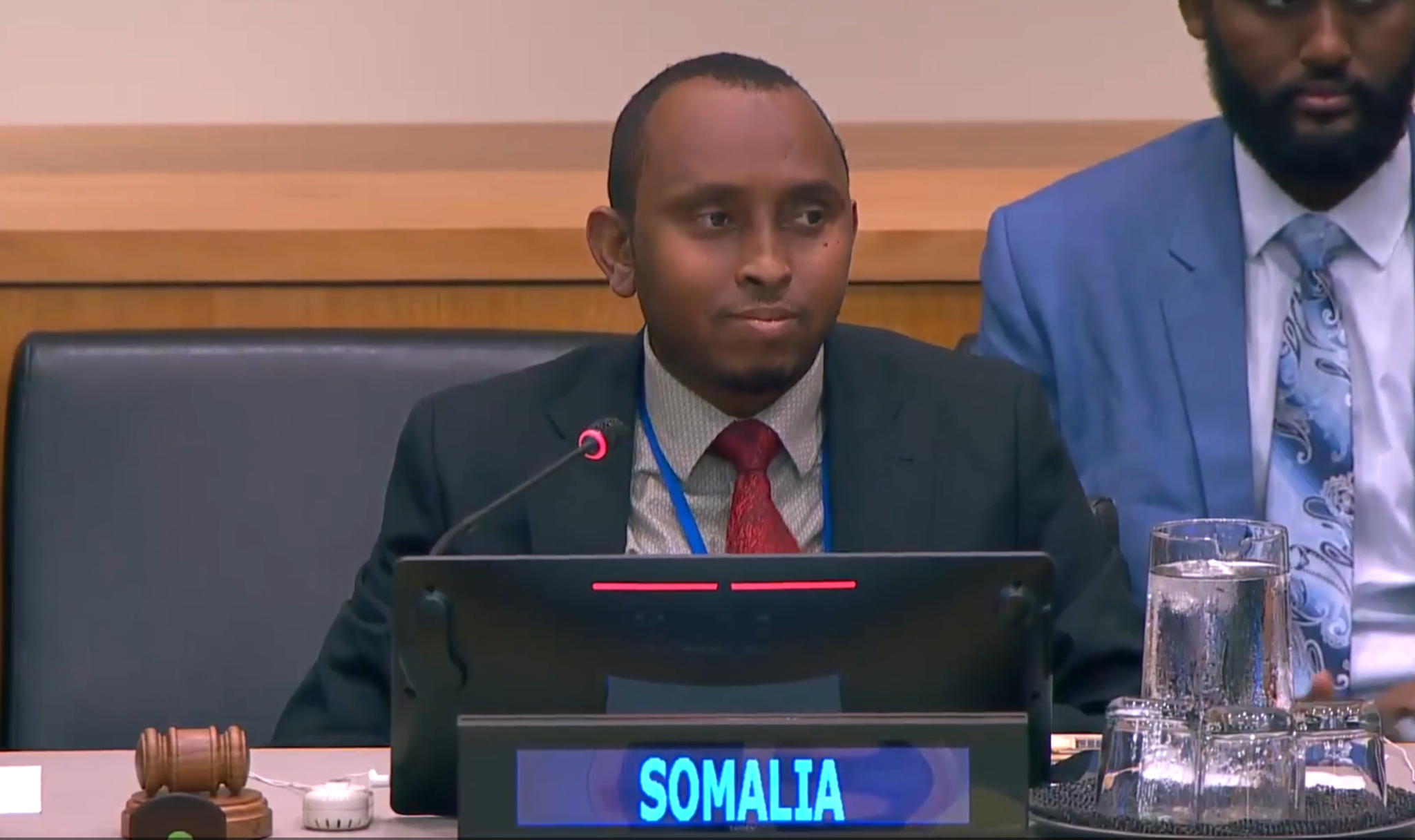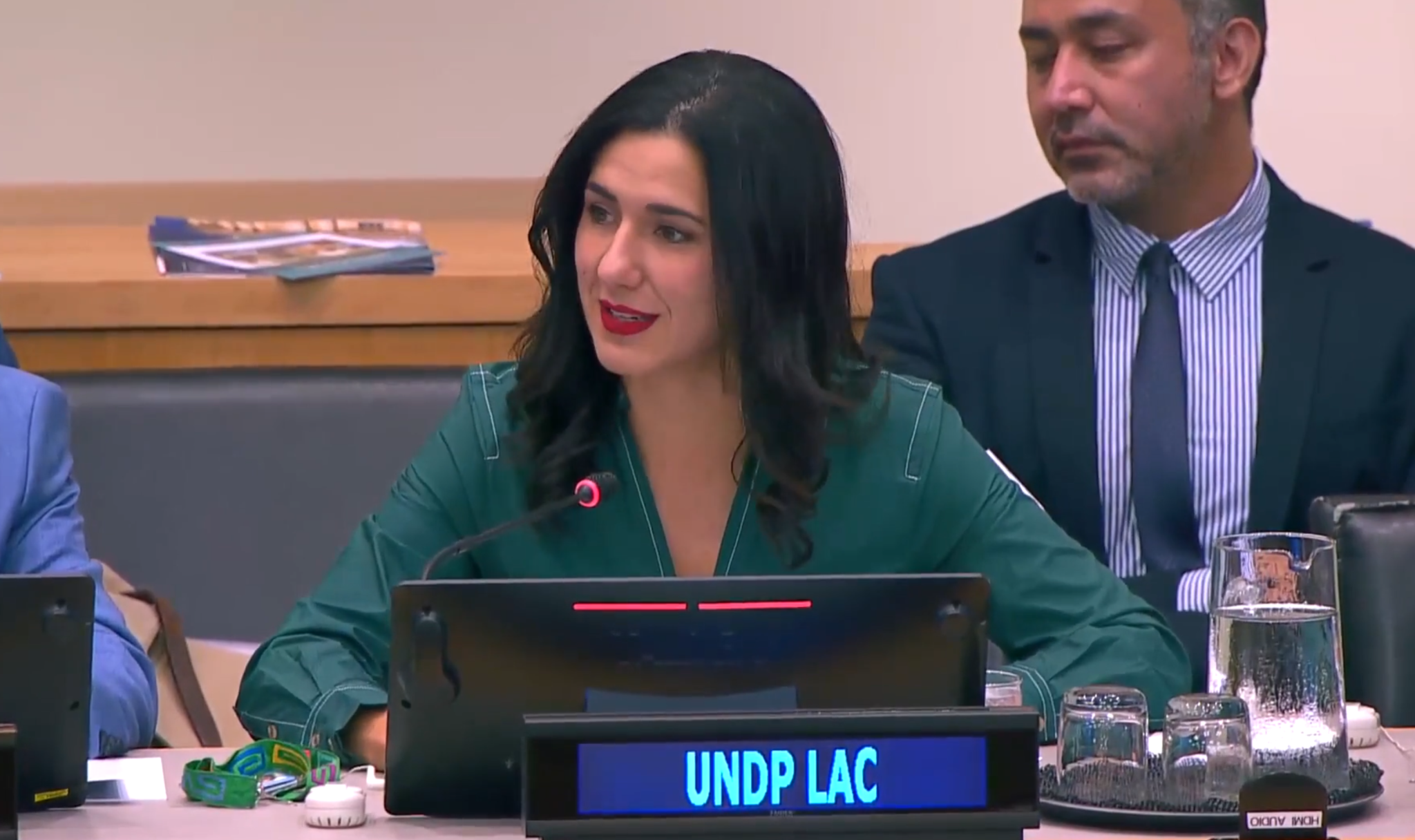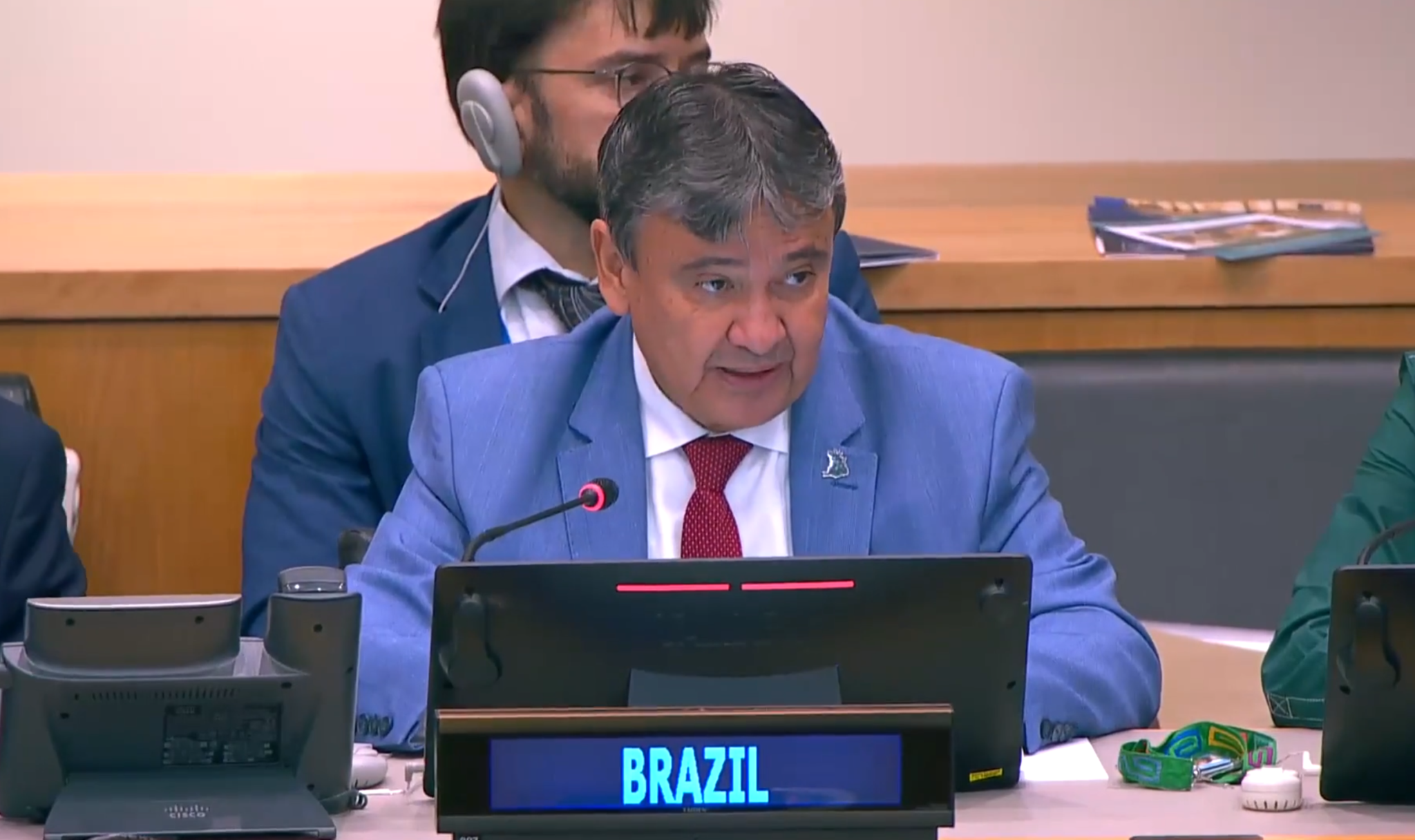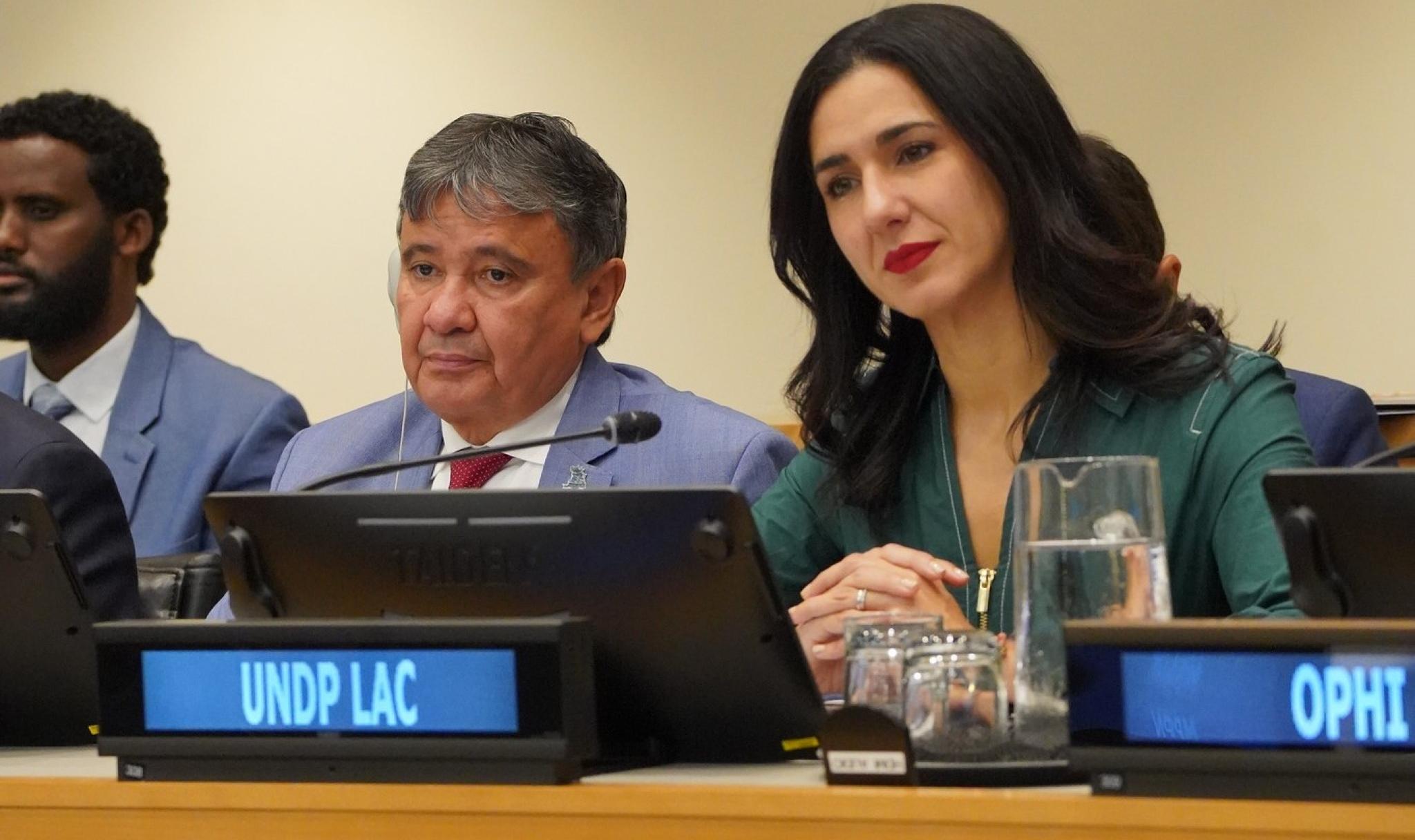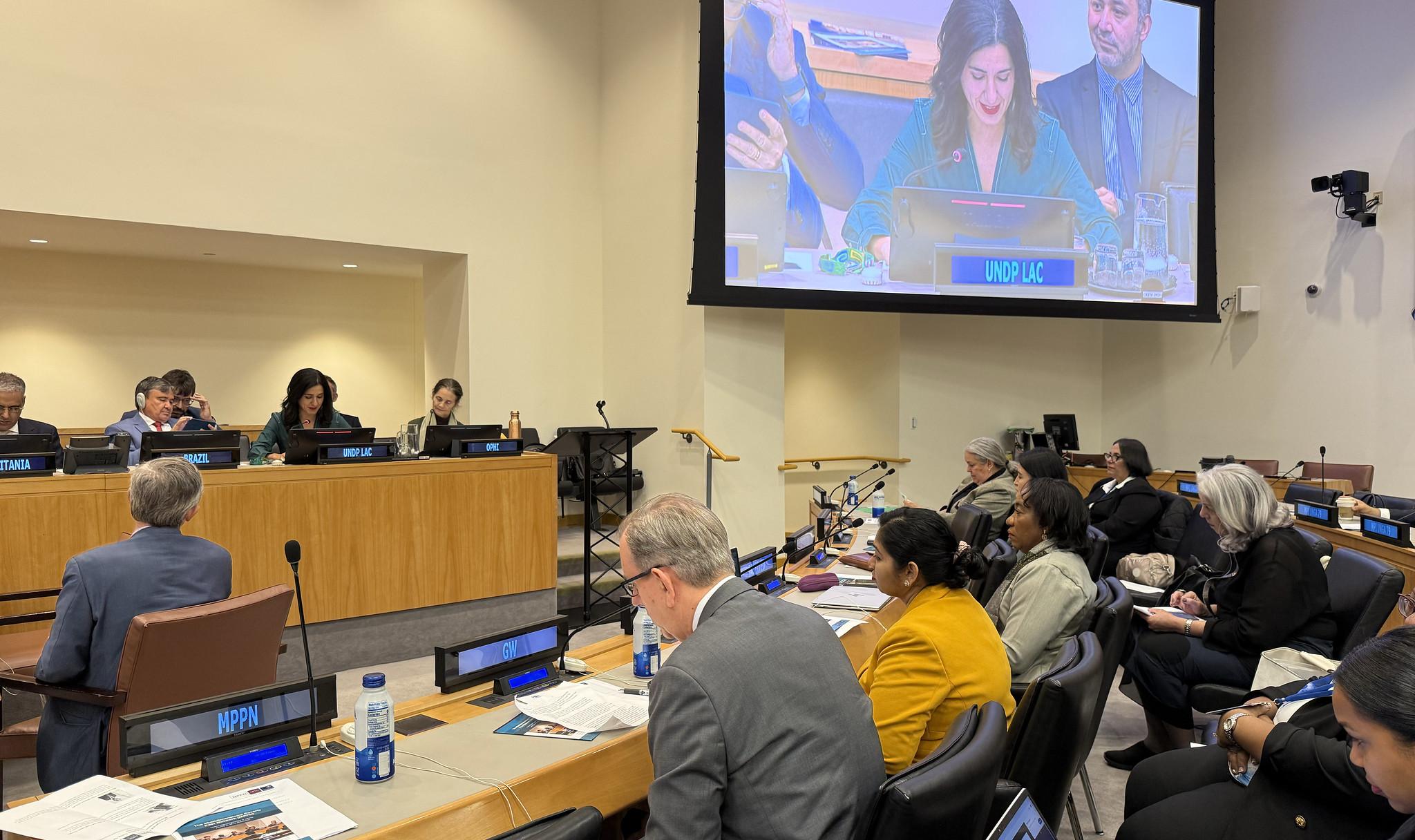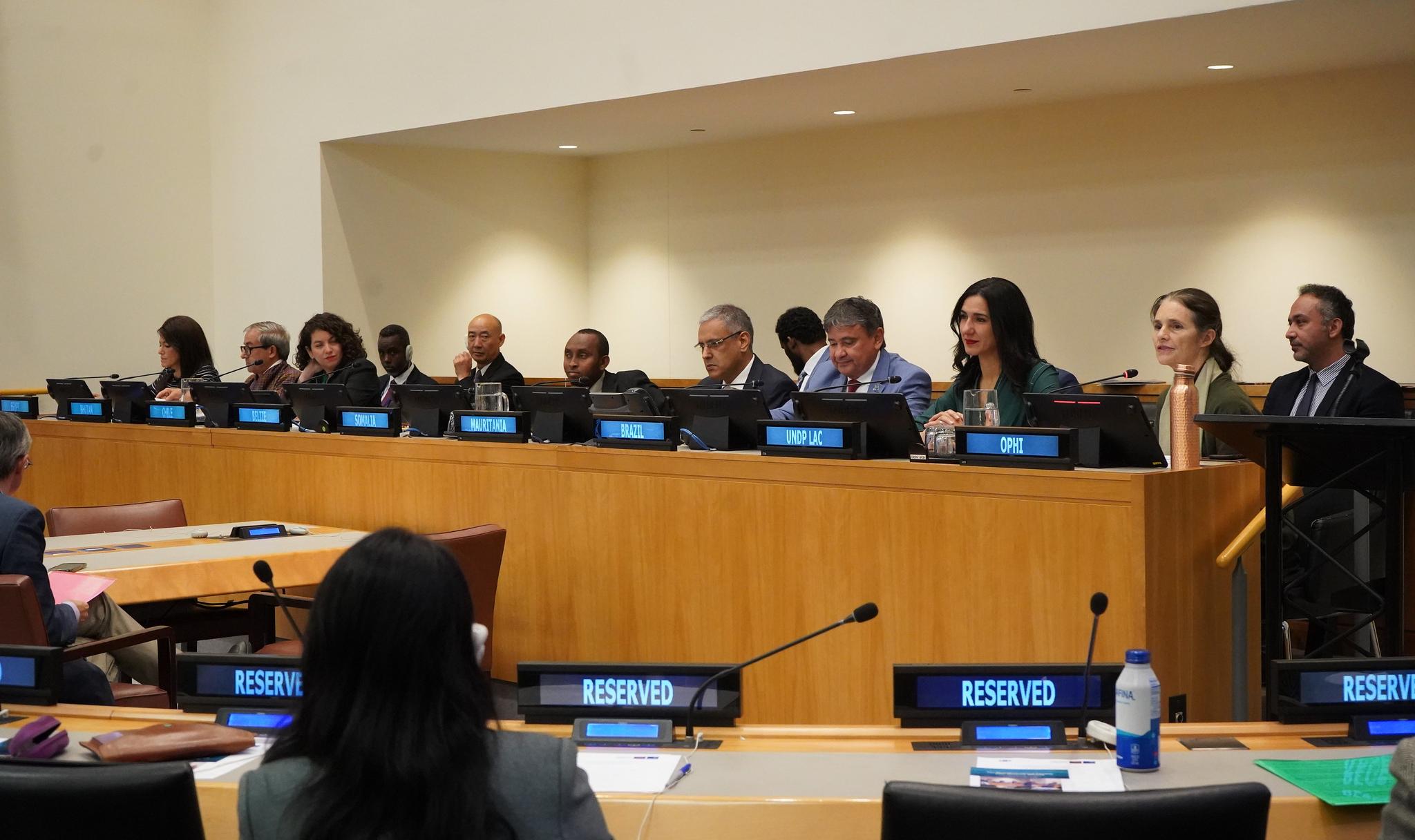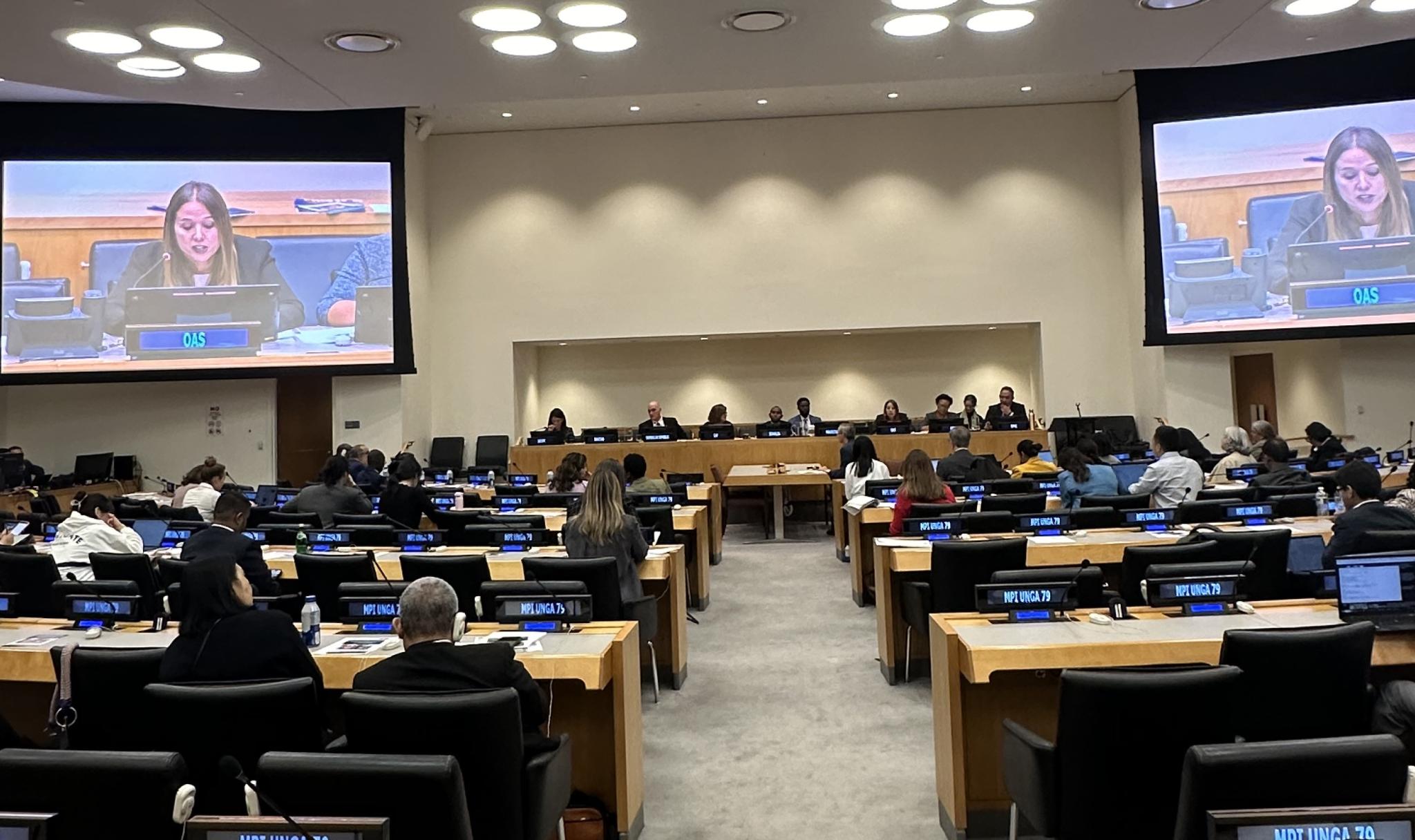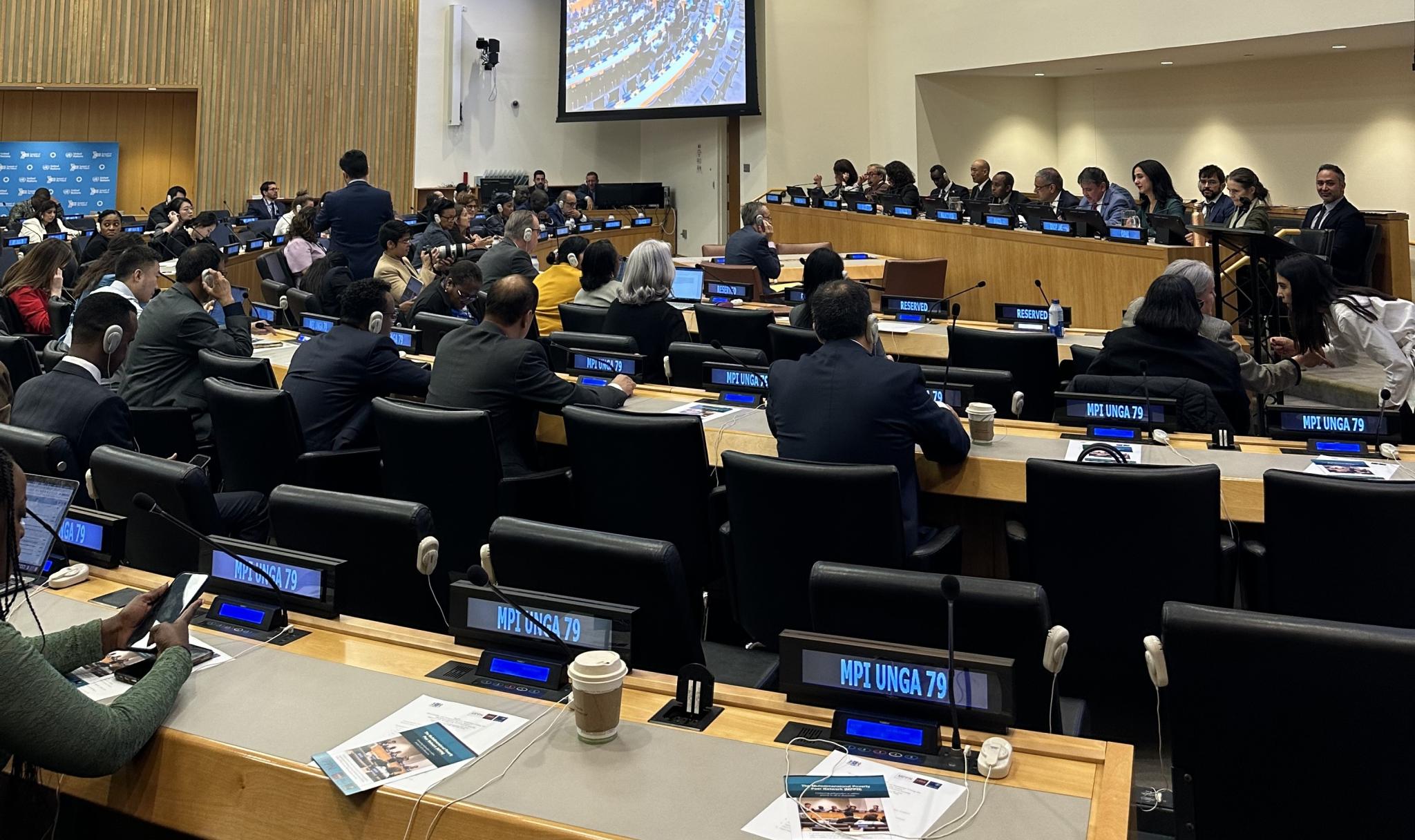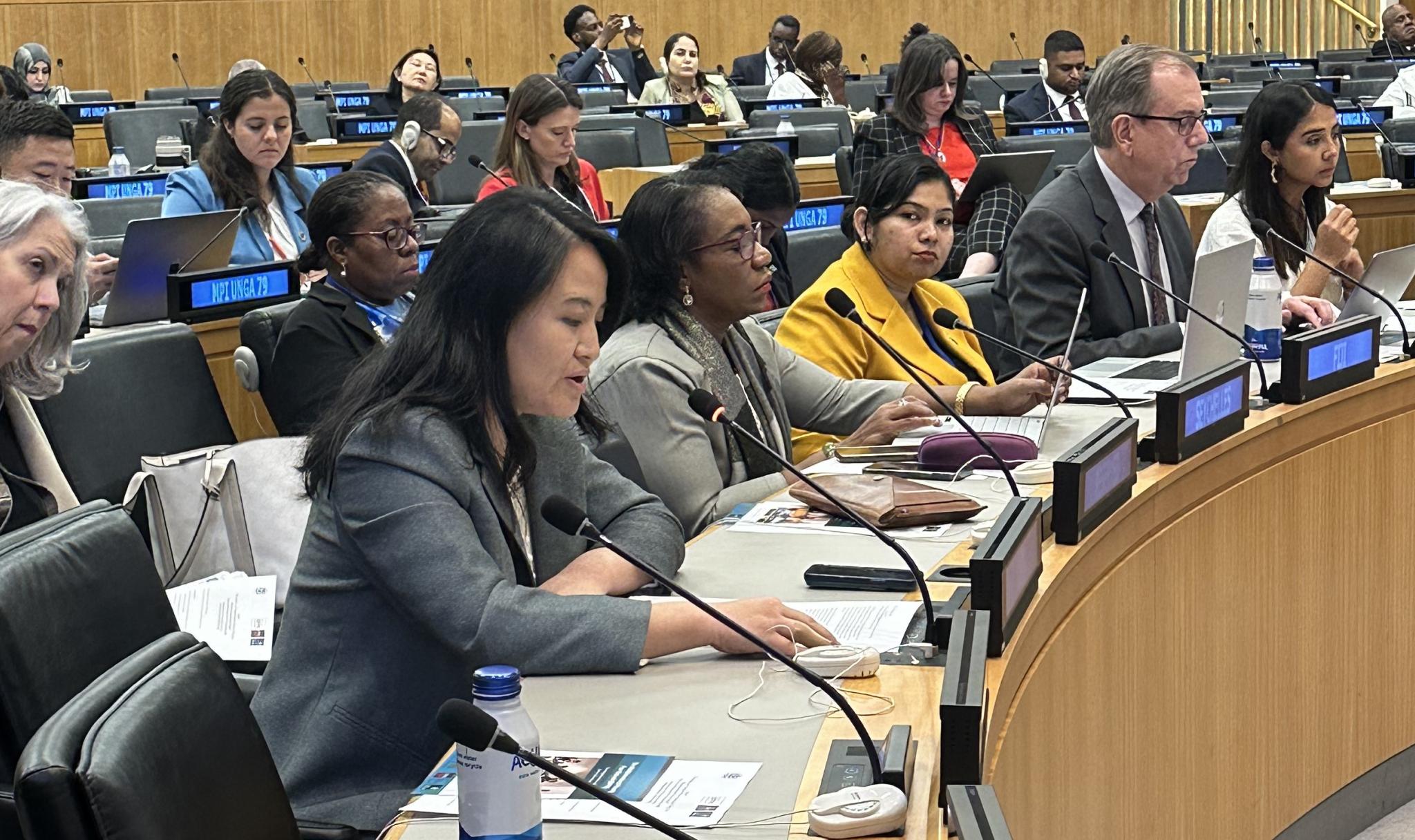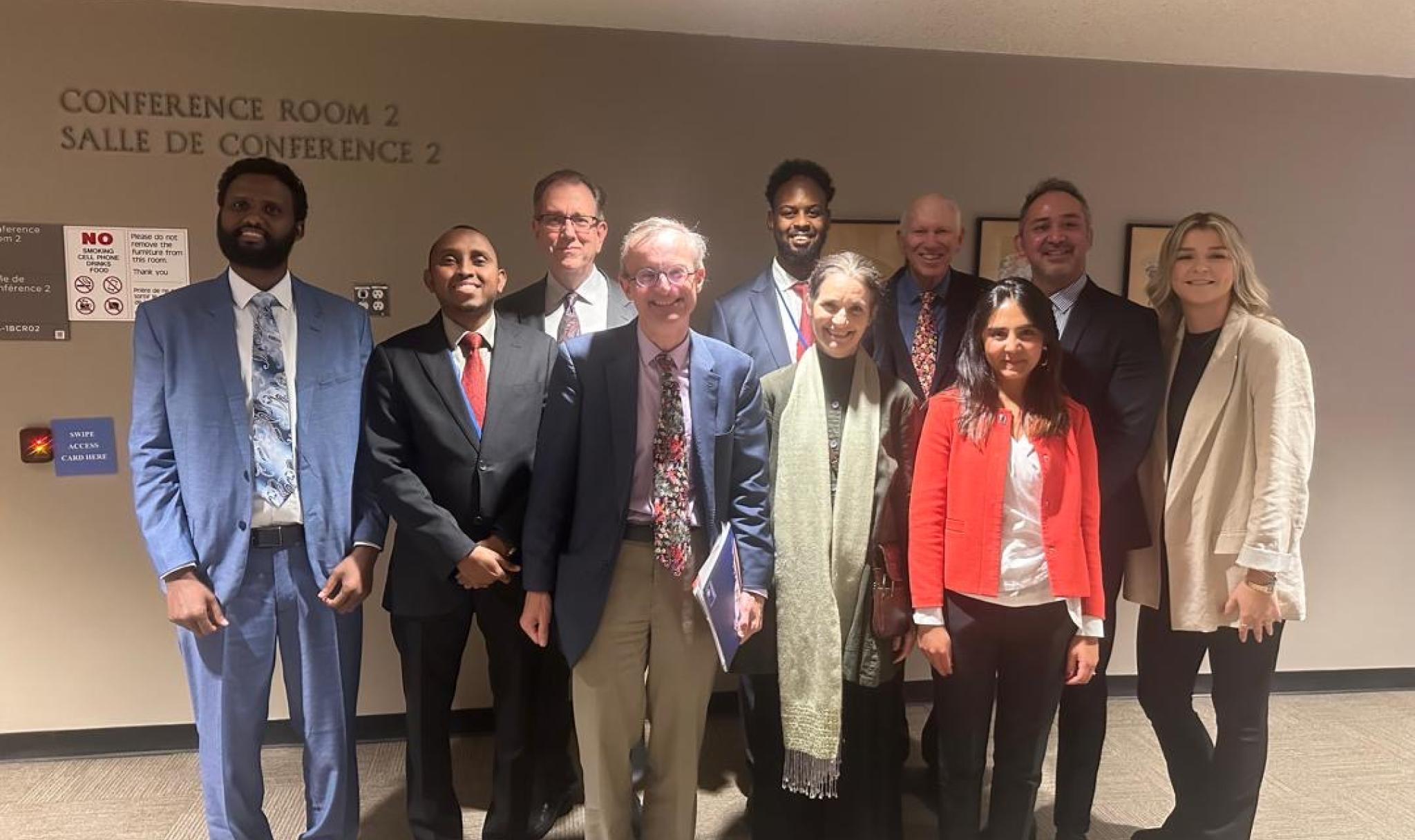‘Our future is not predetermined’: leaders discuss poverty reduction and MPI at UNGA 79 MPPN event
On Tuesday 24 September, the Federal Republic of Somalia and the MPPN co-hosted a High-Level Side Meeting on multidimensional poverty at the UN Headquarters during the 79th UN General Assembly. The event, kindly supported by UNDP Somalia, was entitled ‘Sustainable and Targeted Poverty Solutions: Using the Multidimensional Poverty Index’ and brought together 21 leaders, countries and institutions to share insights from using Multidimensional Poverty Indices (MPIs) as sustainable and targeted poverty solutions.
The representative for Somalia, Yussuf Hassan Isaak, Director General of the Ministry of Labor and Social Affairs, opened the discussion and remarked how a national Multidimensional Poverty Index (MPI) will shortly be released and offers a ‘promising approach’ for Somalia. Somalia’s MPI will provide evidence-based insights that will shape the transformational Somalian National Development Plan in a complex context. Michelle Muschett, UN Assistant Secretary-General & UNDP Director of the Regional Bureau for Latin America and the Caribbean, set the stage for the detailed, determined expositions throughout the day with ringing words of hope: ‘Our future is not predetermined. We live in a world of possibilities, and among those possibilities is ending poverty in all its forms and dimensions.’ With focused clarity José Wellington Barroso de Araújo Dias, Minister of Social Development for Brazil, reiterated this need for visible commitment to poverty: ‘We also have to recognize that the challenge to eradicate hunger and poverty should be top priority.’ He also observed that ‘the persistence of hunger and poverty is not a difficult challenge to tackle…it depends on political will.’
Subsequent speakers demonstrated exactly that political will. The Minister of Planning and Economic Development for Egypt, Rania Al-Mashat, shared how the MPI for Egypt has been aligned with Egypt’s updated National Sustainability Development Strategy 2030 and SDG localization, and will make visible the human impacts of the Decent Life programme among others, and explained five concrete policy uses. For example, by using the MPI ‘we can make informed decisions about where to allocate funds, ensuring that our investments yield the greatest impact’. Sylvester Mbango, Executive Director of the National Planning Commission of Namibia shared how Namibia’s MPI illuminates large disparities across regions and will inform poverty interventions in their sixth National Development Plan. The Honourable Ambassador, Marie-Antoinette Rose Quatre, Chief Executive Officer, Africa Peer Review Mechanism (APRM) invited participants to engage with the APRM Community of Practice on national development planning.
A number of MPIs that are shortly to be launched were energetically presented including by Augustino Ting Mayai, Statistician General, National Bureau of Statistics of South Sudan and Fatima Haram Acyl, Deputy Minister of Economy, Planning and International Affairs, Chad. These MPIs will also be reported as SDG 1.2.2. and will be integrated into National Development Plans and evidence-based interventions.
Speakers spoke candidly about the importance of putting poverty high on the agenda of many actors. Michelle Muschett advocated ‘for a renewed focus on the complexity of poverty in public discourse across the region, bringing it at the forefront of the development dialogue.’ She shared how UNDP views poverty reduction as core to its mandate, and how their strategic plan aims to empower 100 million poor, marginalized and excluded populations to escape poverty and persistent multidimensional vulnerabilities. Pável Ernesto Isa Contreras, Minister of Economics, Planning and Development of the Dominican Republic shared how the revised MPI being developed for the Dominican Republic would use a different survey to ensure that the MPI is regularly updated. The lack of regular data had previously stymied updates of the Dominican Republic’s original MPI.
Innovation and indicator relevance were shared topics among speakers. Nani Ould Chrougha, Minister of Energy, informed the audience that Mauritania had been investing effort in using MPI data to allow Mauritania to find out which regions and which sectors to prioritise so budget allocations could best reduce multidimensional poverty among the poorest of the poor. Javiera Toro Cáceres, Minister of Social Development and Family, Chile, described Chile’s MPI journey incorporating indicators iteratively to include environment, social networks and cohesion. Whereas Lyonpo D. N. Dhungyel, Minister of Foreign Affairs and External Trade, Royal Government of Bhutan, touched on how Bhutan, which launched their first national MPI in 2010 and reduced it dramatically over the next 12 years, published a second MPI with more ambitious indicator thresholds to ensure more accurate budget allocations as they transitioned from the 12th five year developmental plan to the 13th. Marie-Céline Zialor, Minister for Youth, Sports and Family of Seychelles shared her hopes for considering welfare, mental health and belonging in the MPI. And Jamie Coats, CEO of Wise Responder described how the private sector is working with companies in Latin America to reduce MPI among employees or company locations, reminding actors that an informed private sector can lend their impetus to ending poverty.
The importance of multilateralism was a theme many speakers addressed. José Wellington Barroso de Araújo Dias, issued a call to action for participants to support the G20-led Global Alliance against Poverty and Hunger energized by Brazil’s presidency. Poonam Singh, Head of Strategic Planning at the Ministry of Finance for Fiji, affirmed poverty is not ‘our destiny’ and can be overcome through global unity and multilateralism. Alejandra Botero Barco, Planning and Development Impact Manager, CAF Development Bank of Latin America and the Caribbean enumerated how CAF’s agenda included a joint partnership with OPHI and UNDP to train public officials on how to use the MPI for policy design, and leverage MPI data overlaid with climate and environmental data to channel public and private investment in targeted poverty reduction. Betilde Muñoz-Pogossian, Director of the Department of Social Inclusion at the Organization of American States (OAS) described the long history of the OAS’s work to align MPI measures with actionable strategies that improve the quality of life for millions across the Americas and announced a second regional workshop and a compendium on best practices and lessons learned from the Americas with a focus on opportunities for expanding social protection systems. OPHI’s Ana María Marín Morales encouraged countries to come together to report the MPI on the international stage in the SDG Indicators Database and in Voluntary National Reviews and to join the Multidimensional Poverty Peer Network to share candid experiences. She also shared the communiqué highlights from the 2024 MPPN meeting in Uzbekistan, especially a suggestion that UN reports on poverty should use national and global MPIs as scene-setting indicators alongside monetary poverty when describing global poverty’s levels and trends.
The session was an important opportunity to review MPIs in practice and renew commitments to the multidimensional approach. Analysed at the global level, multidimensional poverty levels remain high with 1.1 billion people living in multidimensional poverty across 110 countries – half of whom are children. Yanchun Zhang, Chief Statistician, United Nations Development Programme described how the global MPI, jointly produced by the Human Development Report Office and OPHI, was increasingly recognised as a global standard of multidimensional poverty, hoping that its role would be ‘consolidated more formally in the future’. Beatriz Carles de Arango, Minister of Social Development of Panama shared a strong intention and determination to use the disaggregated global MPI data to improve the conditions of indigenous populations. Professor James Foster, Professor of Economics and International Affairs at The Elliott School of International Affairs at The George Washington University, and co-author of the Alkire-Foster Method, stated his hope that the global MPI would be included among the ‘measures of progress’ on Beyond GDP to be presented at the next UN General Assembly in line with the commitments of the Pact for the Future adopted by member states on Sunday.
The moderators, OPHI Research Associate, Dr Ricardo Nogales, and the Director of OPHI, Sabina Alkire, observed how this movement was gaining momentum, with 43 countries home to nearly 3 billion people reporting a national MPI in the global SDG database, and half as many again with work in progress. They thanked speakers and audiences for their commitment and energy. In closing, Sabina Alkire encouraged all guests to recognise that by working together we are still able in a limited time frame to make huge progress.
List of high-level speakers
- Yussuf Hassan Isaak, Director General of the Ministry of Labor and Social Affairs on behalf of Minister Mohamed Elmi Ibrahim, Minister of Labor and Social Affairs, Somalia
- Michelle Muschett, UN Assistant Secretary-General & UNDP Director of the Regional Bureau for Latin America and the Caribbean
- José Wellington Barroso de Araújo Dias, Minister of Social Development, Brazil
- Nani Ould Chrougha, Minister of Energy, Mauritania
- Javiera Toro Cáceres, Minister of Social Development and Family, Chile
- Lyonpo D. N. Dhungyel, Minister of Foreign Affairs and External Trade, Royal Government of Bhutan
- Rania Al-Mashat, Minister of Planning and Economic Development, Egypt
- Marie-Céline Zialor, Minister for Youth, Sports and Family of Seychelles
- Beatriz Carles de Arango, Minister of Social Development, Panama
- Sylvester Mbango, Executive Director of the National Planning Commission of Namibia
- Pável Ernesto Isa Contreras, Minister of Economics, Planning and Development, Dominican Republic
- Yanchun Zhang, Chief Statistician, United Nations Development Programme on behalf of Achim Steiner, Administrator of United Nations Development Programme
- Augustino Ting Mayai, Statistician General, National Bureau of Statistics of South Sudan, on behalf of the Minister Marial Dongrin Ater, Minister of Finance and Planning
- Fatima Haram Acyl, Deputy Minister of Economy, Planning and International Affairs, Chad
- Poonam Singh, Head of Strategic Planning, Ministry of Finance, Fiji
- Alejandra Botero Barco, Planning and Development Impact Manager, CAF Development Bank of Latin America and the Caribbean
- Betilde Muñoz-Pogossian, Director of the Department of Social Inclusion at the Organization of American States (OAS)
Interventions from the floor:
- Hon Ambassador Marie-Antoinette Rose Quatre, Chief Executive Officer, Africa Peer Review Mechanism
- Jamie Coats, CEO of Wise Responder
- Ana María Marín Morales, OPHI Global Engagement and Events Manager, on behalf of the Multidimensional Poverty Peer Network
- James Foster, Professor of Economics and International Affairs at The Elliott School of International Affairs at The George Washington University
Highlights from speaker statements
-
Yussuf Hassan Isaak, Director General of the Ministry of Labor and Social Affairs on behalf of Minister Mohamed Elmi Ibrahim, Minister of Labor and Social Affairs, Somalia
‘We are currently formulating a transformational National Development Plan that seeks to address the unique challenge our communities face with targeted solutions. By leveraging data and insights from analytical tools such as Multidimensional Poverty Index, we ensure that our National Development Plan are evidence-based and targeted given the complexity of Somalian contexts. The MPI is a promising approach to measuring poverty. It allows us to gain comprehensive understanding of poverty and its various dimensions of how people in Somalia are facing the prevention in access to basic services and opportunities such as water, sanitation, education and food security.’
-
Michelle Muschett, UN Assistant Secretary-General & UNDP Director of the Regional Bureau for Latin America and the Caribbean
‘The Pact of the Future, as already highlighted by Sabina, adopted by world leaders last Sunday, explicitly recognizes poverty in all its forms and dimensions, including extreme poverty as the greatest global challenge and its eradication as an indispensable requirement for sustainable development. In response, member states have committed to place eradication of poverty at the centre of our efforts to achieve the 2030 Agenda by taking comprehensive and targeted measures to address the multidimensional nature of poverty and concrete actions to prevent people from falling back into poverty, by establishing well-designed, sustainable and efficient social protection systems that are responsive to shocks.’
‘Our future is not predetermined. We live in a world of possibilities, and among those possibilities is ending poverty in all its forms and dimensions.’
‘The latest MPPN communiqué chose the way to continue measuring multidimensional poverty through the Multidimensional Poverty Index and encouraging its use as a policy and planning tool with a clear purpose at its heart, putting people at the centre of public policy efforts and development itself. Our experience in Latin America and the Caribbean, reaffirms that this is possible. It has long been a pioneer exploring ways to understand and measure poverty beyond mere income, with initiatives dating back to 1980s since the launch of the MPI by OPHI and UNDP in 2010. Twelve countries in the region, some of them represented here as Chile Dominican Republic and my own home country, Panama, have adopted it as official measures of poverty alongside traditional income metrics. For several decades, the region managed to significantly reduce poverty by introducing innovative public policies focused on solving this issue. However, this trend began to reverse a few years before the pandemic. Revitalizing the poverty reduction agenda requires resuming this innovative capacity and political will. We have done it in the past, and we must do it again.’
‘Poverty reduction is at the core of UNDP mandate, because of its intrinsic link to human development and well being. Decentrality is reflected in our current strategic plan, which sets the ambition of empowering 100 million poor, marginalized and excluded populations to escape poverty and persistent multidimensional vulnerabilities.’
‘Today, the UNDP Bureau for Latin America and the Caribbean, which I have the privilege to lead, is advocating for a renewed focus on the complexity of poverty in public discourse across the region, bringing it at the forefront of the development dialogue. It also demands the creativity and innovation we have demonstrated in the past to explicitly connect these efforts to productivity, climate change, human mobility, citizen security, technological and energy transitions and democratic governance, and this is what lays at the heart of our strategic alliance with OPHI, Sabina and your team, as reflected in our collaboration agreement focus in Latin America and the Caribbean.’
-
José Wellington Barroso de Araújo Dias, Minister of Social Development, Brazil
‘There are multiple dimensions to poverty, and our public policies have to address them so that families don't go back to the cycle of poverty in the face of each shock that happens, we have the ability to understand the specific poverty of each family, the factors that affect each person and family.’
‘Our Ministry in Brazil launched recently an indicator of vulnerability that is used to individually target 96 million people of low income, people that are facing vulnerabilities, to compile an index on the basis of six dimensions that includes 46 programmes, especially that takes into account the needs for care, the development of children, adolescents, the qualification of adults for jobs, conditions, living conditions, among other dimensions.’
‘We also have to recognize that the challenge to eradicate hunger and poverty should be [a] top priority. Let me also indicate that the persistence of hunger and poverty is not a difficult challenge to tackle, as our President says, it depends on political will. And I bring to you some news and a call to action. And although the Global Alliance against Poverty and Hunger was born of the G20, it's an endeavour for all countries to participate in.’
‘President Lula observed today in this building that the problem is that over the past few decades, UN agreements haven't been complied with, so let's act so that we comply with our commitments for the 2030 objectives.’
-
Nani Ould Chrougha, Minister of Energy, Mauritania
‘I'm very proud to share that the Ministry of Economy and Finance has developed and is using its very own national, Multidimensional Poverty Index MPI, one that built on the global MPI yet, but yet captures Mauritania specific deprivations. The National MPI is helping us to learn from the past and plan better for the future.’
‘With the support of the UN, my ministry and the Statistics Bureau of Mauritania (ANSADE), released this first ever national MPI, which was developed jointly with UNICEF and OPHI at the University of Oxford. The National MPI was officially launched this year, and…report is available online. We found that more than half of all Mauritanians were multidimensionally poor in 2019 based on 19 indicators; the average intensity was 56%. In Mauritania multidimensional poverty varied widely. For example, in our capital Nouakchott, the MPI headcount ratio was 31%, whereas in more remote subregions, it reached up to 90%. Given the capital population, however, many MPI poor people do live in Nouakchott.’
‘Within the last year, the government of Mauritania has taken great strides in utilizing the findings of the national MPI for new and comprehensive poverty reduction strategies. With technical support from the UN ESCWA, The World Bank, OPHI and the UN in Mauritania, the Ministry and ANSADE are moving in two directions, first backwards by learning from the past MPI trends, and second forwards by simulating future and ideal scenarios of MPI reductions. With regard to the past, our trend analysis capture[s] MPI trend for all sub national regions, between 2004 and 2019. We have indeed shown and celebrated that some of the poorest regions have moved the fastest in reducing the MPI. The trend analysis also revealed that three of the poorest regions will need additional public investment to also become fast mover at reducing national MPI.'
‘To obtain more frequent updates on the national MPI, we decided to integrate an MPI module in the existing, long established labour force survey for December 2024 onwards. From December 2024 onwards, we will have annual updates on our national MPI for tracking and monitoring of progress made.'
‘With regard to the future, my ministry and ANSADE are investing effort in an MPI optimization model. This model allows us to find out which region and which sector require priority resources to reduce multidimensional poverty among the poorest of the poor. Utilizing the national MPI both to learn from the past trends and to project future trends helps the government of Mauritania to a) address gender inequality b) tackle various and overlapping inequality between and within groups c) reduce poverty in all its forms and thereby improve human development d) and overall, allocate fund more effectively and efficiently.’
-
Javiera Toro Cáceres, Minister of Social Development and Family, Chile
‘Economic growth does not guarantee better living conditions for everyone, so a more comprehensive approach is needed to measure poverty.’
‘MPI was introduced in Chile in 2014. Originally it included four dimensions: education, health, employment and social security and housing. A household is considered to be in multidimensional poverty if it has a 25% or more deprivation in these indicators. However, the original measure overlooked important factors like subjective wellbeing, dignity, respect, environment and social networks. To address these gaps in 2015, we expanded the MPI to five dimensions by widening the housing dimension to housing and environment, and adding social networks and cohesion. This allowed us to better capture how social support, participation and security impact poverty.’
‘Looking forward, a Presidential Advisory Commission is reviewing both the measure of income poverty and the MPI, aiming to update the measures based on the evidence gathered over this past decade. Multidimensional poverty measurement has been key to understanding that income disparity is not the only form of inequality. Social inequality affects opportunities and wellbeing, but it also affects democratic governance, where inequality persists or evolves, the social and political order is seen as unfair. This damages the legitimacy of institution. Addressing inequality with new strategies is a key challenge for our democracy. Understanding poverty and inequality as multidimensional phenomena forces us to devise more ambitious policies that represent a significant step towards a welfare model that not only mitigates the main immediate effects of inequality, but also addresses the structural causes.’
‘In Chile, our policies now have a focus on care, just like Minister Wellington Diaz from Brazil, mentioned with an ageing population, the care crisis is deepening. This exacerbates gender inequality, particularly as women bear more of the caregiving burden. One key initiative is the national systems of support and care, which guarantees the right to care, recognizes it as essential work, whether paid or unpaid, and promotes social and gender equity. Other countries in Latin America, like Brazil, like Colombia, like Uruguay, are moving in the same direction. This system lays the foundation for a social protection framework that addresses one of the root causes of poverty and inequality. It is a clear example of how multidimensional poverty measurement guides public policies that ensure the right to care and promote social justice. In the end, this is not just about reducing poverty and inequality, but about building a more just society where everyone can live with dignity, care and respect.’
-
Lyonpo D. N. Dhungyel, Minister of Foreign Affairs and External Trade, Royal Government of Bhutan
‘The MPI since became central to our policy and planning resource allocation as we transition from the 12th five year developmental plan to the 13th, we recognized the need to revise the MPI threshold to ensure more accurate budget allocations. Originally designed to measure acute poverty, Bhutan's MPI is aligned with the global MPI, but includes roads, land, livestock and food security in place of undernutrition. Over the past five years, Bhutan's MPI rate dropped from seven percentage points, reducing multidimensional poverty from one in eight people to one in seventeen. Despite the challenges of the pandemic between 2017 and 2022, multidimensional poverty fell from 5.8% to 2.1% with significant reductions in every indicator. In 2022, 17.8% of our population experienced moderate, multidimensional poverty with disparities between urban and rural areas. Notably, 61.4% of the poor live in rural regions, emphasizing the need for targeted interventions. The MPI enables us to monitor progress by region, age group and more, ensuring policies reach those most in need. While we have made substantial progress, Bhutan remains vulnerable to external shocks such as climate change and economic disruptions that threaten poverty reduction gains. Bhutan's leadership has long recognized that income-based measures are insufficient. We have embedded wellbeing metrics into our policy framework, and strong political leadership remains critical to reducing poverty and ensuring accountability.'
‘Bhutan reaffirms its commitment to working with the multidimensional poverty peer network to share insights and build global partnerships. We firmly believe that multidimensional poverty measures are key to creating sustainable, effective poverty reduction strategies worldwide.’
-
Rania Al-Mashat, Minister of Planning and Economic Development, Egypt
‘The Ministry of Planning, Economic Development and International Cooperation, in collaboration with these teams partners such as the Central Agency for Public mobilization and Statistics, the Ministry of Social Solidarity…on the national side [and] on the international side, with UN ESCWA, as well as Oxford Poverty and Human Development Initiative and UNICEF, we have been working to develop the Multidimensional Poverty Index that reflects complex realities faced by the Egyptian population.’
‘Our national MPI is comprehensive. It encompasses seven critical dimensions: education, health, housing, services, employment, social protection and food security. These dimensions are assessed through 19 carefully selected indicators with inputs from national experts and stakeholders.’
‘The MPI will be instrumental in tackling the impacts of major initiatives, national initiatives, such [as the Decent Life Initiative and also [the] Presidential initiative, 100 million Health. This initiative is not occurring in isolation. It is deeply integrated into our broader national strategies as well. The MPI aligns with the updated National Sustainability Development Strategy for Egypt 2030, as well as supports localization of SDGs at the regional level. It is closely connected with key national programmes such as the Decent Life program, which aims to improve living conditions in rural areas 4,500 villages across the country, as well as the National Family Planning Programme, which focuses on enhancing health and wellbeing.’
‘The MPI serves several vital functions. First, it enables us to design more targeted and evidence-based policies. By identifying areas with the highest levels of deprivation, we can focus our resources and interventions where they are needed most. This targeted approach helps us address specific issues such as nutrition, health, education and ensuring that our efforts are both efficient and effective. Second, the MPI facilitates better allocation and prioritization of budgets with detailed data on various dimensions of deprivation, we can make informed decisions about where to allocate funds, ensuring that our investments yield the greatest impact. And here at UNGA this year, we launched our integrated National Financing Framework. Third, it provides a robust framework for monitoring and evaluation. By using the MPI as a benchmark, we can track progress over time and assess the effectiveness of our poverty reduction strategies, including major initiatives. This ongoing evaluation allows us to adopt and respond to emerging challenges. Fourth, the MPI helps in crafting informed poverty reduction strategies. It provides a comprehensive view of poverty beyond income, allowing us to address the root causes of deprivation and work towards sustainable solutions. Fifth, the MPI highlights our progress and identifies areas where we still face challenges. It makes visible the positive change in quality of life and helps the public recognize the impact of our development efforts. Moreover, it captures the effects of external shocks such as pandemics and geopolitical events on various indicators, providing a valuable tool for future planning and resilience building.’
‘As we move forward, we are committed to launching Egypt's national MPI and using it to guide our poverty eradication strategies. We will continue to work with UNESCWA and the Oxford Poverty and Human Development Initiative to enhance our statistical capacity and integrate new models and modules into household surveys. These steps will help us capture the full scope of human development and address critical issues such as care work, equal treatment and women's empowerment.’
‘In conclusion, the MPI is more than just a measurement tool. It's a guidance, it guides towards a more inclusive and equitable future by understanding and addressing the multifaceted nature of poverty, we can make meaningful progress in improving the lives of all Egyptians.’
-
Marie-Céline Zialor, Minister for Youth, Sports and Family of Seychelles
‘...the first multidimensional poverty study for Seychelles was held in 2019 by our National Bureau of Statistics and the poverty alleviation department, and with further assistance from the Oxford Poverty and Human Development Initiative.’
‘I think for the future, we think we need to maybe broaden the definition of poverty, especially in context to countries like Seychelles, and I'm referring to here with dimensions or indicators that has to do more with welfare and well being of people, and focusing more on the human being, rather than always on the human doing.’
‘...we also have issues with young people. I work with young people a lot with mental health, and I can tell you in a village, even when you have all the basic needs and you have everything, and then you have got people that cannot live with each other, where you have high level of violence and other things like that, I would consider them as being poor. So I would think that we will need to probably move and then broaden the scope and the dimensions and also include other criteria that we can use in the multi[dimensional] poverty index so to ensure that all countries are fairly represented.’
-
Sylvester Mbango, Executive Director of the National Planning Commission
‘The Multidimensional Poverty Index is a useful tool to measure poverty and deprivation in the country…It can be tailored to the conditions of a particular country, and it can be calculated at the lowest level, in our case, at the constituent constituency level. In as much as Namibia has invested quite substantial efforts to reduce poverty and inequality since independence, multidimensional poverty revealed to us in 2021 that poverty remains high at a level of 43%. This level of poverty is higher in the context of Namibia being an upper-middle-income country. In contrast with income poverty, which remains moderate high, poverty in Namibia reduced from the levels of around 70% in 1990s to about 17% in 2016 which is a recommendable achievement. The higher income levels generalize to the Namibian people using the per capita income stems from the the high paying economic activity, activities such as mining and other tertiary industries, which benefits only a few leaving out the majority who rely on subsistence and informal economic activities. The incidence of multidimensional poverty in rural areas is estimated at around 60% while in urban areas hovers around 25%...Now that we are moving forward to our sixth National Development Plan, we are going to use the multidimensional poverty as our basis for identifying our policy interventions.’
-
Yanchun Zhang, Chief Statistician, United Nations Development Programme on behalf of Achim Steiner, Administrator of United Nations Development Programme
‘On [Achim Steiner’s] behalf, we at UNDP are committed to empower 100 million people, poor, marginalized and excluded, to exit persistent, multidimensional poverty and vulnerabilities and MPIs are a key part of our strategy, because they animate high impact, evidence based actions to end poverty in all its forms.’
‘For years, UNDP has been supporting national MPIs such as those, some of those shared today here, and to publishing the global MPI reports, jointly with OPHI. UNDP offices in countries across the world, supported MPI related activities. The very recent examples are UNDP Uzbekistan supporting the global MPPN meeting in Tashkent and UNDP Somalia supporting today's event here.’
‘So what is the global MPI and what does it contribute? All of us may have heard of the World Bank's $2.15 poverty indicator. Since 2010 UNDP and OPHI have complemented this with the global MPI, based on the methodology developed by Sabina and Professor James Foster here.’
‘The global MPI began at the margins, but is becoming a global standard. It appears in Africa's Agenda 2063, the 2017 World Bank report on measuring global poverty, and the 2019 Global Sustainable Development report. Then this year, our global MPI data also appear in World Bank's World Development Indicators, among other data sharing sites. In short, the global MPI sets the scene globally on the level and trends of multidimensional poverty, complementing the bank's World Bank's measure of extreme monetary poverty. I hope its role is consolidated more formally in the future to continue our work on multidimensional poverty, to track whether UNDP itself is successfully lifting, helping, lifting people out of poverty. We request all involved in data collection not to leave multidimensional poverty data behind.’
‘I'm pleased to mention that our upcoming report, the 2024 global MPI report will focus on poverty and conflict. We will release our joint report and data on October 17 this year, and please do look out for this new study.’
-
Augustino Ting Mayai, Statistician General, National Bureau of Statistics of South Sudan, on behalf of the Minister Marial Dongrin Ater, Minister of Finance and Planning
‘While the government is making strides in implementing the public financial management reforms to enhance service delivery, developing measures that reflect the needs of our people, such as the MPI, is key. [The] government of South Sudan, the Ministry of Finance and Planning and the National Bureau of Statistics, with support from UNDP, is finalizing its pilot national MPI that is informed using cross sectional data. As we endeavor to produce comprehensive data that enabled the computation of a more improved MPI, while bolstering our analytical capabilities, the pilot MPI will momentarily be used to guide related policies. And in July this year, the government utilized the provisional results of the pilot MPI to inform the country's first National Voluntary Review, the implementation and the interim outcome of the SDGs. The pilot MPI will also guide the formulation and monitoring of our next development strategy. And with sustained leadership by the Ministry of Finance and planning, backed by the National Bureau of Statistics, all concerned South Sudan's institutions and development partners are encouraged to draw from the measure to design multifaceted interventions, improve the lives of the left behind groups and track progress.’
-
Fatima Haram Acyl, Deputy Minister of Economy, Planning and International Affairs, Chad
‘The government of Chad, with the technical support of the Oxford Poverty and Human Development Initiative and financial support from UNICEF, had just developed its very first rigorous multidimensional poverty index, covering five dimensions and 17 indicators. From now on, Chad will use the Multidimensional Poverty Index to enhance monitoring of the fight against poverty as an effective tool for targeted, objective and efficient intervention for the population..
‘Chad will soon publish its first report on the Multidimensional Poverty Index, which will serve as a policy tool to effectively reduce the deprivation that currently diminish life and hope in our country.’
‘Our commitment is to work so that we will see significant changes in charge in the near future, with the effective implementation of the President's social project, which consists of 12 initiatives and 100 actions fully integrated into the National Development Plan. More job, stronger housing, energy, water, dignified sanitation facility, road and health care for all as well, action in favor of gender, particularly in education. The MPI of Chad, will make our success in this area effective and visible.’
-
Poonam Singh, Head of Strategic, Planning, Ministry of Finance, Fiji
‘We have embraced a holistic multidimensional approach, where we prioritize education, health, employment generation and equitable resource distribution to reduce income disparities.’
‘I'd like to share some key policy initiatives adopted by Fiji towards poverty alleviation and improving our MPI. Firstly, the Social Protection Programme, which increases the purchasing capacities of household… we introduce[d] the poverty graduation programme to support the vulnerable households to move out of poverty. Secondly, supporting income generating opportunities through [an] integrated national poverty eradication programme. Third, investment in education and skill development. Fourth, strength in partnership with faith-based organizations, civil society organizations and private sector to accelerate progress of poverty alleviation, for instance, engagement of private actors in health sector through public private partnerships…Other strategies include community-based tourism and sustainable agriculture practices to enhance food security and livelihoods. By addressing both economic and social dimensions of poverty, we are creating opportunities that uplift the entire communities. We also recognize that gender equality and empowering women is critical for achieving a holistic development.’
‘As poverty is not our destiny. It is a challenge that we can overcome through global unity and multilateralism.’
-
Beatriz Carles de Arango, Minister of Social Development, Panama
‘We use this as a tool to manage poverty and define specific indicators and align them to the realities in our countries. With our approach, we have a technical body set up to monitor and to measure MPIs constantly and then to analyze them. Given the multi sectoral nature of our social development approach, we have involved the Ministry of Social Development, Economy, Finance and the National Statistics and Census Institute. We use bespoke MPIs as well to provide information on specific indicators, for example, on girls, boys and teenagers…This has enabled us to define high needs areas and to develop strategies to combat poverty, given its various dimensions and indicators.’
‘The MPI provided us a good guide so that we could draft public policies. One example of that is the changes that we're carrying out now to the social management legislation. MPI has also enabled different institutions to respond to shortfalls in specific priority areas by identifying patterns of poverty in specific areas.’
‘We need to promote a nexus between the multidimensional funding approaches to poverty and greater and more effective involvement of the government. We are also looking at experiences in other countries using bespoke MPI so that we can guide our own efforts in this area, and we are reviewing the indicators in order to keep them up to date and ensure that they are still relevant when we take decisions. We use the MPI approach to design public policies, and that enables us to have sustainable social management approach. We innovate, and we use new technology for assessing the data and using MPI, and finally, we include our indicators in our surveys so that we can be part of the global MPI, and in this way, we can better understand our real situation within the global context.’
-
Pável Ernesto Isa Contreras, Minister of Economics, Planning and Development, Dominican Republic
‘The country’s first experience constructing a national MPI was in 2015, it was initially made possible with the support of OPHI, the UNDP and the Vice President of the Dominican Republic. After a period of using the MPI between 2015 and 2019, it was discontinued due to the lack of consistent data and surveys required to calculate the index annually. As part of the Poverty Committee’s 2024 work agenda, a national and official MPI is currently being developed. This effort began in August 2023 with a significant focus on combining quantitative and qualitative methods to construct a national MPI. The process includes not only technical expertise and also the perceptions of poverty by those who experience it this is the plan to implement focus group to legitimise the process…the first step…was to secure an already institutionalised and permanent instrument to ensure that the MPI is updated annually…the multipurpose household survey conducted annually by the National Statistics Office was selected as the most appropriate instrument to calculate the national MPI for the country. Currently the technical poverty team from the Committee is leading the construction of the official MPI. They began conducting analysis sessions focused on determining the dimension and indicators the MPI should include drawing on previous experiences and the practices of other countries in the region such as Colombia and Uruguay…the first MPI proposal will emerge from these sessions, which will be complemented by the input and knowledge of the sectorial institutions and the result of participatory consultation processes. Next year the country will have its first MPI to complement the monetary measures of poverty.’
-
Alejandra Botero Barco, Planning and Development Impact Manager, CAF Development Bank of Latin America and the Caribbean
‘Amongst others, Latin America is now the region with the lowest projected growth globally. And to reverse this trend, we need not only political commitment, but also robust tools like the Multidimensional Poverty Index, which offers deeper insights into poverty and enables the creation of more effective policies. CAF stands by to support these efforts with over 50 years of experience. CAF is dedicated to sustainable development and regional integration as the only multilateral institution fully owned by Latin American and Caribbean countries.’
‘CAF’s agenda is aligned with the region's unique needs. Having committed to over 200 billion to the region, we affirm our dedication to poverty reduction as a key pillar of our mission. Our focus is on developing tools and knowledge that can empower countries to design impactful public policies, supporting their efforts to meet the Sustainable Development Goals, particularly those related to poverty.’
‘As the Green Bank for sustainable and inclusive development, CAFaddresses poverty through multiple dimensions. We engage in critical sectors such as housing, water, sanitation and energy, but we have to go beyond traditional loans. CAF promotes initiatives in job creation, fair energy transition and infrastructure development, but we need more support from other development banks to go hand in hand, to support our each of the member countries in these efforts’.
‘In partnerships with UNDP, CAF is advancing a joint agenda that strengthens countries' capacity to measure and utilize data for more effective public policies. OPHI will play a pivotal role in this effort, helping train public officials to apply the MPI in policy development and most importantly, we are committed to innovating and financial instruments that can help mobilize resources towards poverty reduction. By leveraging MPI metrics, we can identify, for example, specific social objectives such as reducing MPI or a specific dimension, and integrate them into blended finance mechanisms. This approach will allow us to channel both public and private investment into targeted poverty reduction initiatives across the region.’
‘This event offers a crucial platform for leaders to exchange experiences and reinforce their commitments using the MPI to drive poverty reduction, political leadership is indispensable in realizing these goals. The time is now to implement these strategies that not only alleviate social needs, but also guarantee well being for all. And Caf remains a steadfast part, steadfast partner in this vital effort.’
-
Betilde Muñoz-Pogossian, Director of the Department of Social Inclusion at the Organization of American States (OAS)
‘As the oldest regional organization and the main political forum of the Americas, the OAS brings together 34 member states from the region to promote democracy, human rights, security and sustainable development. Within this mission recognizing poverty as a multidimensional challenge has become a fundamental priority in our collective agenda.’
‘In fact, since 2009 in collaboration with OPHI, the OAS has emphasized the importance of addressing poverty, not merely as an issue of income, but as a complex web of social, economic and cultural deprivations.’
‘A critical milestone in this journey was the creation of the working group on multidimensional poverty within the Inter American Committee on Social Development. I am very glad that Minister Javiera Toro from Chile, who leads this committee, as well as the ministry, Minister Beatriz Carles from Panama, who presides over this working group, were here with us today. Their leadership has been instrumental to advance this work. The working group focuses on strengthening the institutional capacities of member states and ensuring that the information from the index and various measurements informs public policy design. The mandate this group, working group, has is very clear, to align poverty measurement with actionable strategies that improve the quality of life for millions across the Americas. The collaboration fostered by this group has been nothing short of transformative. It has created synergies between institutions responsible for measuring poverty and those charged with designing the policies that reduce it. The working group chaired by the Minister of Social Development of Panama, and vice-chaired by Trinidad and Tobago represents a collect collective effort that includes also countries such as Mexico, Canada, Guatemala, Paraguay, Barbados and Peru.’
‘In 2017 I also wanted to mention we deepened our partnership with OPHI by signing a joint declaration that formalized our commitment to collaborative projects to improve multidimensional poverty measurements and policies in the Americas. Through this partnership, we have developed key initiatives, including a compendium on experiences and lessons learned from the measurement of multidimensional poverty in the Americas, which reflects the power of shared knowledge in driving meaningful change.’
‘Next month, the working group will host its second regional workshop on multidimensional poverty, best practices and lessons learned from the Americas with a focus on opportunities for expanding social protection systems. In this forum, member states will come together to share progress, reflect on lessons learned and explore how multidimensional poverty measurement is changing the landscape across the region.’
‘The commitment of OAS member states to eradicating poverty is unwavering. We believe that with a multidimensional approach, robust data and solid regulatory frameworks, we can deliver targeted, sustainable solutions. The challenge before us is great, but through political will, strategic partnerships and the effective use of data, we can transform poverty into a story of hope and success for our communities.’
-
Hon Ambassador Marie-Antoinette Rose Quatre, Chief Executive Officer, Africa Peer Review Mechanism
‘I also take note Chair of the high participation of women in this important discussion’
The African Peer Review Mechanism the APRM is an African Union self-monitoring mechanism voluntarily exceeded by African countries to promote good governance on the continent. Further, the aprm has been designated by heads of state to support African countries on monitoring and evaluation governance aspects of Agenda 2063 and Agenda 2030 for sustainable development. Our comprehensive governance reviews and targeted reviews can leverage on the Multidimensional Poverty measurement to enhance evidence-based data concerning aspiration one of agenda 2063, which meets SDG one, end of poverty and two, fighting hunger. This collaboration is beneficial for African countries to develop adequate social justice, national-led programmes. It is imperative to hear from countries like Chad, Somalia, Mauritania, Seychelles, Namibia, South Sudan and Egypt and countries from the global south about national efforts to improve reporting poverty from a multidimensional perspective. However, we must acknowledge the negative impact of COVID 19, alongside ongoing conflicts for pushing more than 600 million African citizens under the poverty line.'
‘Moreover, the APRM is committed to equally work on stabilization of countries in political transitions, so SDGs and Agenda 2063, including poverty, can be addressed. From the perspective of the APRM, eradicating poverty in Africa, it's not just a social economic endeavour. We support our member states to build strong policies focused on efficient public service delivery, including social economic governance policies which deliver with impact.'
'Moreover, our country review reports provide key recommendations which inform the national plan of actions for implementation. Our holistic approach, working with both state and non-state actors, ensure that no one is left behind at the decision-making table.'
‘The APRM also supports the cause from our African member states this morning, to broaden the lens through which we measure poverty, we need to also, also include and consider country-specific dynamics.’
‘I invite you all to engage with the APRM Community of Practice on national development planning, which has been established since 2019 to sustain the speed-learning and knowledge-sharing of successful practices towards poverty measurement, alongside other NDP issues in Africa. This will open avenues for collaboration to fulfil financial gaps in pursuant of our development agendas while ensuring that no one is left behind.’
-
Jamie Coats, CEO of Wise Responder
‘...if you encourage the private sector to use an MPI with your indicators, you put them, so to speak, on the same KPIs, the same targets as you and it enables you to partner more effectively and essentially bring free resources, from your perspective, to solve the problems.’
‘Vale has made a commitment, a social ambition, commitment to help take half a million people out of poverty in the Brazilian Amazon by 2030 by using direct measurement of the MPI. And I'm going to use this moment just to give you a couple of extraordinary examples of what this can do. We've already surveyed 10,000 households and 40,000 people, and the first thing that it’s shown is, what can the company do directly, and what do they need to partner with the government? It's enabled them to understand that they can actually get people access to government services they don't have. 50% of the municipally-identified people did not have access to federal programs they were eligible for. It enabled the company to understand they could help with education, getting kids in school, health and nutrition, but it also showed that they needed to collaborate with municipalities around electricity, water and sanitation, and it also enabled them to understand clustering of problems, so they saw low income combines with lack of cooking fuel and food insecurity into a difficult cluster and you need to solve it together. And it showed that low school attendance, lack of sanitation and a lack of electricity were another cluster. This is an example of how the private sector can engage. So, I encourage you to invite them to the table.’
-
Ana María Marín Morales, OPHI Global Engagement and Events Manager, on behalf of the Multidimensional Poverty Peer Network
‘At our latest Annual Meeting held three weeks ago with the Government of Uzbekistan, participants called for four things. First, for countries and institutions to develop MPIs and use them as policy tools to accelerate poverty eradication in all its forms. Second, to collect multidimensional poverty data often…Third, to report national MPIs in the SDG global database and in VNRs and SDG reports. And finally, and innovatively, actors called leading global institutions to acknowledge and profile the level of trends of Multidimensional Poverty Indices, national and global, as scene-setting indicators when describing global level trends of poverty. In particular, the communiqué suggested the upcoming global fora at the 2030 agenda reports include the official national MPI levels and trends reported against SDG 1.2. It also suggests that the global MPI levels and trends for over 6 billion people, which are produced by UNDP jointly with OPHI that and reported in the World Bank's World Development Indicators be used for scene-setting purposes.’
-
James Foster, Professor of Economics and International Affairs at The Elliott School of International Affairs at The George Washington University
‘Last weekend, at the Summit of the Future, the gathered Assembly adopted and released a Pact for the Future that calls for work to urgently develop measures of progress on sustainable development that goes beyond Gross Domestic Product - measures that span economic, social and environmental dimensions. We are closing two hours in which over 20 senior leaders spoke about such measures. As a professor who has worked intensely on poverty measurements since 1980, I want to say one thing we must remember, the energy, the passion and the rigour in this room as we look to the future. The Pact for the Future requests that a high-level expert group is established to consider new measures of progress. I would like to propose that the MPIs and similar wellbeing indices, like Bhutan's GNH index, are included among the core measures of progress to be presented at next year's UN General Assembly. For how can the world progress if poverty reduction is snarled or stalled? Indeed, the Declaration of Future Generations this week called loudly for the eradication of poverty in all its forms and dimensions.'
'Now imagine a world in which actors in government, business, academia, civil society and the youth align their determination, their resources, their creativity and networks to advance wellbeing, using an international GNH index to fight poverty using multidimensional and monetary poverty indices. Imagine a world where the UN Secretary General's report sets the scene by reporting a global MPI that headlines integrated progress in human capital and capabilities and reports, MPI and monetary poverty trends globally and by national definitions? In my view, MPIs alongside inclusive growth, climate justice, peace and GNH should be core indicators of progress. But even more importantly are the energy, the passion and the rigor exemplified by the people in this room using MPIs to transform the lives of people.’



